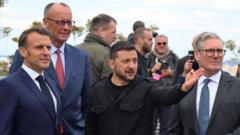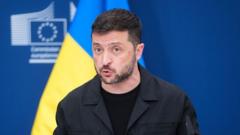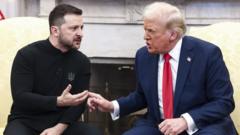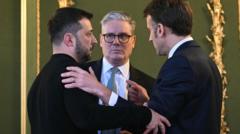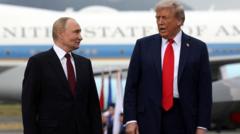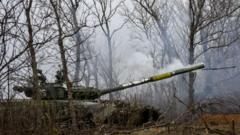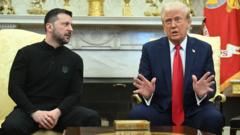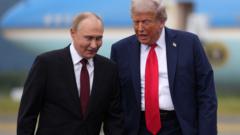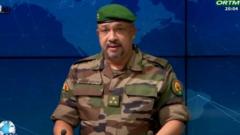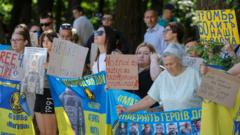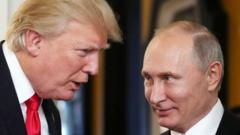As leaders from key nations gather at the White House for crucial discussions on the Ukraine conflict, diverging goals and pressures emerge, highlighting the complexity of the situation.
What Each Party Aims for in Ukraine Talks at the White House
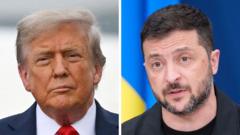
What Each Party Aims for in Ukraine Talks at the White House
World leaders congregate to discuss Ukraine's future amidst escalating tensions and varying agendas.
In an unprecedented show of political unity, leaders from the US, UK, France, Germany, Italy, Finland, the EU, and NATO convene at the White House to engage in high-stakes negotiations aimed at resolving the ongoing war in Ukraine. Initially anticipated as a bilateral conversation between US President Donald Trump and Ukrainian President Volodymyr Zelensky, the meeting has evolved into a summit reflecting the urgency and multifaceted nature of the crisis.
From the US perspective, President Trump's priority appears to be achieving any form of agreement, even if the specifics remain unclear. Trump has shifted his rhetoric following recent discussions with Russian President Vladimir Putin, pressuring Zelensky to forgo aspirations for NATO membership and concede territories such as Crimea that Russia annexed in 2014. The Trump administration seems to balance its previous resistance to European calls for security guarantees for Ukraine with a new focus on deterring further Russian aggression.
On the Ukrainian side, President Zelensky faces a daunting challenge as he stands against Trump's demands to yield territory, especially in the regions of Donetsk and Luhansk where Ukrainian troops have fought valiantly. The potential for territorial concessions without solid security guarantees exacerbates Zelensky's predicament, as he seeks to avoid giving Russia the opportunity to leverage the acquired land for further military actions against Ukraine.
Meanwhile, European leaders attending the talks are focused on demanding a clear commitment from the US regarding Ukraine’s security. They are apprehensive about the implications of the US pressuring Ukraine to cede land and are keen to avoid historical precedents where borders are redrawn by force. The gathering underscores Europe’s concern for its long-term stability in light of increased Russian assertiveness.
Despite the absence of a Russian presence at the White House, Moscow’s interests loom large over the negotiations. Russia seeks renewed confirmation that Ukraine will not join NATO and desires increased territorial control in the Donbas region. Such demands mirror Trump’s apparent inclination to shift the onus of a resolution onto Zelensky, accentuating the precarious situation faced by Ukraine amidst external pressures.
As the leaders engage in discussions, the outcome will likely have lasting implications not only for Ukraine but also for regional and global stability as various agendas collide in the complex geopolitical landscape surrounding the conflict.
From the US perspective, President Trump's priority appears to be achieving any form of agreement, even if the specifics remain unclear. Trump has shifted his rhetoric following recent discussions with Russian President Vladimir Putin, pressuring Zelensky to forgo aspirations for NATO membership and concede territories such as Crimea that Russia annexed in 2014. The Trump administration seems to balance its previous resistance to European calls for security guarantees for Ukraine with a new focus on deterring further Russian aggression.
On the Ukrainian side, President Zelensky faces a daunting challenge as he stands against Trump's demands to yield territory, especially in the regions of Donetsk and Luhansk where Ukrainian troops have fought valiantly. The potential for territorial concessions without solid security guarantees exacerbates Zelensky's predicament, as he seeks to avoid giving Russia the opportunity to leverage the acquired land for further military actions against Ukraine.
Meanwhile, European leaders attending the talks are focused on demanding a clear commitment from the US regarding Ukraine’s security. They are apprehensive about the implications of the US pressuring Ukraine to cede land and are keen to avoid historical precedents where borders are redrawn by force. The gathering underscores Europe’s concern for its long-term stability in light of increased Russian assertiveness.
Despite the absence of a Russian presence at the White House, Moscow’s interests loom large over the negotiations. Russia seeks renewed confirmation that Ukraine will not join NATO and desires increased territorial control in the Donbas region. Such demands mirror Trump’s apparent inclination to shift the onus of a resolution onto Zelensky, accentuating the precarious situation faced by Ukraine amidst external pressures.
As the leaders engage in discussions, the outcome will likely have lasting implications not only for Ukraine but also for regional and global stability as various agendas collide in the complex geopolitical landscape surrounding the conflict.

